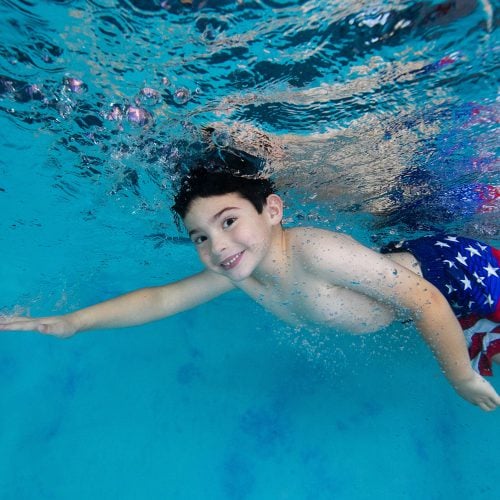 Most of us were taught to tread water as children. It was considered an essential safety skill, and it is still used by lifeguards, water polo players, and the US Navy, to name a few. However, there are some common misconceptions when it comes to young swimmers treading water.
Most of us were taught to tread water as children. It was considered an essential safety skill, and it is still used by lifeguards, water polo players, and the US Navy, to name a few. However, there are some common misconceptions when it comes to young swimmers treading water.
What is Treading Water?
Treading water is a technique that allows a swimmer to remain upright in an essentially stationary position with the head above water. The hands move in a sculling movement, while the legs kick in a breaststroke or scissors kick. Alternatively, the eggbeater or rotary kick may be used.
While treading water, the swimmer kicks with just enough energy to remain upright and keep his or her head above water. The body position is vertical or nearly vertical in the case of the eggbeater kick.
Energy Required
Treading water is often touted as a way to conserve energy. You were probably taught as a child that you could tread water to take a break. Yet treading water still burns a considerable number of calories. In fact, it burns so many calories that many fitness groups advocate its use to lose weight.
While treading water is useful in certain situations, we should be careful of thinking that our children can tread water for long periods of time in life-threatening scenarios. In fact, the U.S. Navy makes no mention of conserving energy by treading water in its Swimming and Water Survival manual. Instead, it states that keeping your head out of water takes significant effort.
The U.S. Navy recommends treading water to check for floating objects, survivors, and rescue crafts, and while activating flotation equipment or signaling for rescue. Lifeguards and water polo players also find value in treading water. Both often use the eggbeater kick to tread water so that their hands are free.
When it comes to conserving energy, however, treading water is not the best choice. Floating requires less energy.
Effectiveness
Treading water can be very effective in the situations described above. In sudden accidents, soldiers are able to tread water to assess their surroundings, look for other survivors, activate flotation devices, and call for rescue. Lifeguards can free the use of their hands to help swimmers. Athletes participating in water polo and synchronized swimming similarly tread water to remain upright and have independent use of their arms.
How effective is treading water for young swimmers? The American Red Cross does include treading water for one minute as part of their water competency skills. Being able to tread water for one minute may provide time to signal for help, but as we previously discussed, it takes quite a lot of energy to tread water for any length of time.
Effectiveness can also depend on the circumstances. For example, the U.S. Search and Rescue Task Force (USSARTF) says that in cold water, attempting to tread water or swim can half survival times. The USSARTF defines cold water as any water under 70 degrees but effects vary based on the individual and the temperature of the water.
If, for example, your child falls into a pond in winter, or your boat capsizes on a fall fishing trip, treading water could be harmful. Huddling with others or floating in a position that conserves body heat is a better choice.
At Bear Swim School, we teach flip to breathe as a survival skill. Being in a vertical position, such as when treading water drains your child of energy. In dangerous situations, flipping to breathe allows swimmers to float on their backs and rest while taking in air. Both experienced and inexperienced swimmers can recover using this technique.
If you’re ready to enroll your child in swim lessons or would like to learn more about the techniques we teach at Bear Paddle Swim School, such as flip to breathe, contact us today.
